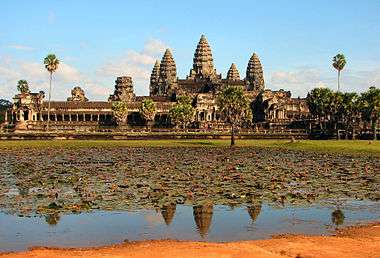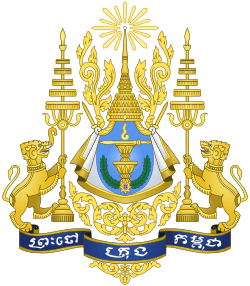Cambodia–Thailand relations
 |
|
Cambodia |
Thailand |
|---|---|
Bilateral relations between Cambodia and Thailand date back to the 13th century during the Angkor Era. Thailand was once Cambodia's arch-enemy. Border disputes in Preah Vihear Province have been on-going since 2008 when the Preah Vihear Temple was listed as a UNESCO World Heritage Site.
Cambodia has an embassy in Bangkok and Thailand has an embassy in Phnom Penh.
History
Angkor Era
.jpg)
Following Jayavarman VII's death, Khmer experienced a gradual decline. Important factors were the aggressiveness of neighboring peoples (especially the Thai, or Siamese), chronic interdynastic strife, and the gradual deterioration of the complex irrigation system that had ensured rice surpluses. The Angkorian monarchy survived until 1431, when the Thai captured Angkor Thom and the Cambodian king fled to the southern part of the country.
Longvek Era
The Thai conquest of the new capital at Lovek in 1594 marked a downturn in the country's fortunes and Cambodia. Becoming a pawn in power struggles between its two increasingly powerful neighbors, Siam and Vietnam. Cambodia remained a protectorate of Siam. Vietnam's settlement of the Mekong Delta led to its annexation of that area at the end of the 17th century. Vietnam employed a strategy similar to those of North American pilgrims and pioneers: settle and claim. Such foreign encroachments continued through the first half of the 19th century. A successful invasion by Vietnam further limited Thai protectorship in Cambodia and established the kingdom under full Vietnamese suzerainty.
French Protectorate of Cambodia
To prevent the two neighbors, Siam and Vietnam, from swallowing Cambodia, King Norodom invited France to make Cambodia its protectorate, on 11 August 1863. Cambodia remained under France's rule until 9 November 1953.
Cold War
During the 1970s, Khmer Rouge ruled Cambodia as Democratic Kampuchea carrying out the Cambodian genocide. This caused many Cambodian refugees fleeing to the Thai border to escape Pol Pot's regime.
On 1 January 1979, Vietnam invaded Kampuchea and removed Khmer Rouge from power replacing it with the Soviet-backed People's Republic of Kampuchea escalating into an eleven year war. Thailand refuses to recognize the PRK and continues to support the deposed Democratic Kampuchea though Khmer Rouge and the two non-communist factions assembled the Kampuchean government-in-exile backed by the People's Republic of China, North Korea, ASEAN and the other Western powers. During that period, the Vietnamese soldiers attacked refugee camps near the Thai-Cambodian border over the course of its annual dry seasons.
By the time Communist regimes in Eastern Europe collapsed, Vietnam withdrew its troops from Cambodia in late 1989 leading up to the 1991 Paris Peace Accords which paved way for the restoration of monarchy in 1993.
Conflicts and disputes
2003 riots
In January 2003, riots broke out in Phnom Penh after a Cambodian newspaper incorrectly reported that a Thai actress had stated Angkor Wat properly belonged to Thailand. On 29 January, the Thai embassy was burned, and hundreds of Thai immigrants fled the country to avoid the violence.[1] Cambodians in Phnom Penh burned photos of King Bhumibol Adulyadej and Thais in Bangkok protested in front of the Cambodian embassy, burning Cambodian flags. This eventually led to the Thai government to sever diplomatic ties with Cambodia.[2] Prime Minister Hun Sen banned Thai shows and films on TV stations.
2008 border disputes
The conflict between Cambodia and Thailand over land adjoining the site has led to periodic outbreaks of violence.
A military clash occurred in October 2008.[3] In April 2009, 66 stones at the temple allegedly were damaged by Thai soldiers firing across the border.[4] In February 2010, the Cambodian government filed a formal letter of complaint with Google Maps for depicting the natural watershed as the international border instead of the line shown on the 1907 French map used by the International Court of Justice in 1962.[5]
In February 2011, when Thai officials were in Cambodia negotiating the dispute, Thai and Cambodian troops clashed, resulting in injuries and deaths on both sides.[6] Artillery bombardment in the area occurred during the conflict. The Cambodian government has claimed that damage occurred to the temple.[7] However, a UNESCO mission to the site to determine the extent of the damage indicates that the destruction is a result of both Cambodian and Thai gunfire.[8][9]
Since February 4, both sides have used artillery against each other, and both blame the other for starting the violence.[10] On February 5, Cambodia had formally complained in a letter to the U.N. "The recent Thai military actions violate the 1991 Paris Peace Accord, U.N. Charter and a 1962 judgment from the International Court of Justice", the letter claims.[11] On February 6, the Cambodian government claimed that the temple had been damaged. Cambodia's military commander said: "A wing of our Preah Vihear temple has collapsed as a direct result of the Thai artillery bombardment".[12] However, Thai sources spoke only of minor damage, claiming that Cambodian soldiers had fired from within the temple.[13]
ASEAN, to which both states belong, has offered to mediate over the issue. However, Thailand has insisted that bilateral discussions could better solve the issue.[10] On February 5, the rightwing People's Alliance for Democracy called for the resignation of Prime Minister Abhisit Vejjajiva for "failing to defend the nation's sovereignty".[10]
An UNESCO World Heritage convention held in Paris in June 2011 determined to accept Cambodia's management proposal for the temple. As a consequence, Thailand withdrew from the event, with the Thai representative explaining, "We withdraw to say we do not accept any decision from this meeting."[14]
Following a February 2011 request from Cambodia for Thai military forces to be ordered out of the area, judges of the International Court of Justice (ICJ) by a vote of 11–5 ordered that both countries immediately withdraw their military forces, and further imposed restrictions on their police forces. The court said this order would not prejudice any final ruling on where the border in the area between Thailand and Cambodia should fall.[15] Abhisit Vejjajiva said that Thai soldiers would not pull out from the disputed area until the military of both countries agree on the mutual withdrawal. "[I]t depends on the two sides to come together and talk," he said, suggesting that an existing joint border committee would be the appropriate place to plan a coordinated pullback.[16] The ICJ ruled on 11 November 2013 that the area around and below the temple belongs to Cambodia and that any Thai security forces still in that area should leave.[17][18]
See also
References
- ↑ "Cambodia apologises to Thais". BBC News. 30 January 2003. Archived from the original on 16 March 2013. Retrieved 1 August 2012.
- ↑ John Aglionby. "Thais cut links with Cambodia after riots | World news". The Guardian. Retrieved 2016-10-22.
- ↑ "Let's deal with this calmly". Bangkok Post. January 27, 2011.
- ↑ Sambath, Thet (8 April 2009). "Preah Vihear Damage Significant". The Phnom Penh Post.
- ↑ Cambodia Complains of Google Map Mistake at Preah Vihear Temple Archived January 21, 2013, at the Wayback Machine.
- ↑ Schearf, Daniel (February 4, 2011). "Thailand, Cambodia Border Fighting Breaks Out Amid Tensions". Voice of America.
- ↑ Petzet, Michael (2010). "Cambodia: Temple of Preah Vihear". In Christoph Machat, Michael Petzet and John Ziesemer (Eds.), "Heritage at Risk: ICOMOS World Report 2008-2010 on Monuments and Sites in Danger" (PDF). Berlin: hendrik Bäßler verlag, 2010
- ↑ UNESCO (February 8, 2011), UNESCO to send mission to Preah Vihear, unesco.org, retrieved June 6, 2011
- ↑ UNESCO (February 6, 2011), Director-General expresses alarms over escalation of violence between Thailand and Cambodia, unesco.org, retrieved June 6, 2011
- 1 2 3 "Shells fly around the temple". The Economist. February 7, 2011. Retrieved February 7, 2011.
- ↑ "Thailand, Cambodia trade shots, charges over ancient temple". CNN. February 8, 2011.
- ↑ "Thai-Cambodia clashes 'damage Preah Vihear temple'", BBC, February 6, 2011
- ↑ "เขมรเวอร์จริง บันไดนาคโดนสะเก็ดถลอก แต่โวยวายพระวิหารใกล้พัง - Manager Online". Manager.co.th. Retrieved 2016-10-22.
- ↑ "Thailand quits heritage body amid temple row". Sin Chew Daily. AFP. 26 June 2011. Retrieved 26 June 2011.
Suwit said that Thailand took the decision because the Convention agreed to put Cambodia's proposed management plan for the Preah Vihear temple on its agenda.
- ↑ "UN orders troops away from temple". The Independent. July 18, 2011. Asia. Retrieved 18 July 2011.
- ↑ Arthur Max (July 18, 2011). "UN court draws DMZ for Thai, Cambodia troops". The San Francisco Examiner. AP. Retrieved 18 July 2011.
- ↑ "Preah Vihear temple: Disputed land Cambodian, court rules". BBC News. November 11, 2013. Retrieved 11 November 2013.
- ↑ "Judgment: Request for Interpretation of the Judgment of 15 June 1962 in the Case Concerning the Temple of Preah Vihear (Cambodia v. Thailand)" (PDF). Recorded by L.Tanggahma. The Hague, Netherlands: International Court of Justice. 2013-11-11. Retrieved 2013-11-16.



